Woodbridge by Robert Mondavi
by
Terry Sullivan
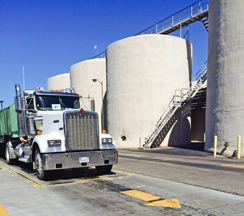 Summary: Robert Mondavi grew up in Lodi, so it is no wonder that he would purchase a winery close by and create affordable wines that pair well with everyday dinners. A visit to the winery and a tour will show you a very large winery that produces millions of bottles of wine.
Summary: Robert Mondavi grew up in Lodi, so it is no wonder that he would purchase a winery close by and create affordable wines that pair well with everyday dinners. A visit to the winery and a tour will show you a very large winery that produces millions of bottles of wine.
Woodbridge by Robert Mondavi is one of the few very large production wineries in the United States. Annual production under the Woodbridge label is about nine million cases. Wine enthusiasts can visit the tasting room on Woodbridge Road in Acampo near the town of Lodi. Robert Mondavi attended Lodi High School. While visiting Woodbridge take one of the scheduled tours. You will get a sense of the immense facility while on tour.
The winery facility is like a campus including many buildings. This was one of the first facilities built to produce wine after the repeal of prohibition in 1933. In 1979, Robert Mondavi bought the facility and produced 120,000 cases of Woodbridge wine. Mondavi wanted to make fruit-forward wines with California grapes for everyday enjoyment.
The winery sources about one-third of the wine grapes grown in the Lodi wine region. The Lodi wine region produces 18% of all grapes grown in California.
Winery Tour
Wine travelers will observe the scope of a large production facility while on the winery tour. Our tour visited several of the buildings. While outside, we noticed trucks moving about the campus. Workers often travel from one building to another on bicycles. The roads have delineated walking areas for those workers and tourists walking. Our guide wore a bright green color shirt that is easily seen by the traffic around the buildings.
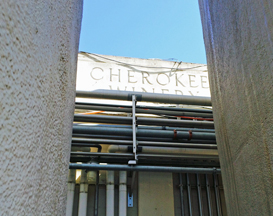 Our first stop was the original building of the Cherokee Winery that opened in 1933. Now the building is used for storage. Of interest is a shack on the second floor balcony. The shack was used by government officials, a gentle reminder that alcohol is taxed. As we walked along the pedestrian path on the roadways, we noticed many tanks. We were told that there are 165,000 tanks including new tanks under construction that each have the capacity of around 650,000 gallons. Optimally, the tanks would only be at 60% to 70% capacity. If the tanks were full to 100% capacity, the winemaking staff would find it difficult to create blends since there would be no place to hold the wine.
Our first stop was the original building of the Cherokee Winery that opened in 1933. Now the building is used for storage. Of interest is a shack on the second floor balcony. The shack was used by government officials, a gentle reminder that alcohol is taxed. As we walked along the pedestrian path on the roadways, we noticed many tanks. We were told that there are 165,000 tanks including new tanks under construction that each have the capacity of around 650,000 gallons. Optimally, the tanks would only be at 60% to 70% capacity. If the tanks were full to 100% capacity, the winemaking staff would find it difficult to create blends since there would be no place to hold the wine.
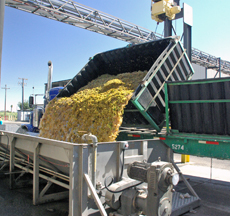 There were trucks entering and leaving the 80-acre campus. We saw one truck unloading white grapes into a destemmer crusher. The truck had four bins filled with grapes. An overhead crane was attached to one side of the bin and lifted that side causing the grapes to fall into the long stainless steel crusher. When the bin was almost empty we noticed a straw hat. It too fell into the crusher. A worker used a pitch fork to remove the hat or MOG (material other than grapes.)
There were trucks entering and leaving the 80-acre campus. We saw one truck unloading white grapes into a destemmer crusher. The truck had four bins filled with grapes. An overhead crane was attached to one side of the bin and lifted that side causing the grapes to fall into the long stainless steel crusher. When the bin was almost empty we noticed a straw hat. It too fell into the crusher. A worker used a pitch fork to remove the hat or MOG (material other than grapes.)
Our tour proceeded to a building that housed several bottling lines. There are several sections to the massive bottling line. Each section operates faster than the section before it. The fully automated bottling line was filling several hundred 1.5 liter bottles per minute. At the end of the line, after being corked, labeled and capsule attached, the bottles were packed into boxes. The speed and accuracy were interesting to note.
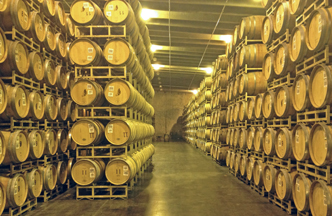 Our last stop on the tour was a barrel aging building. The building we entered had 60,000 barrels stacked in racks six high.
Our last stop on the tour was a barrel aging building. The building we entered had 60,000 barrels stacked in racks six high.
Wines
Returning to the tasting room we sampled several wines.All the wines tasted were in the Winemaker’s Selection Series, an exclusive to the tasting room. The 2013 Sauvignon Blanc Lodi AVA was a bright yellow color with 13.0% alcohol. This light-bodied crisp wine had notes of tropical fruit and citrus with some minerality. The wine retails for $14. The 2013 Rosato California was a rosé of Syrah. The light red color wine had 13.5% alcohol. It too was light-bodied and it offered red berry fruit on the aroma and taste. The wine retails for $14.
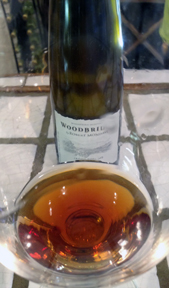 The 2012 Barbera Lodi AVA had a dark ruby color with 14.4% alcohol. Black cherries and cloves were noticeable on this full-bodied wine with bold tannins. It retails for $14.
The 2012 Barbera Lodi AVA had a dark ruby color with 14.4% alcohol. Black cherries and cloves were noticeable on this full-bodied wine with bold tannins. It retails for $14.
The Section 29 Zinfandel Lodi AVA was named after the Section 29 of the Volestead Act (Prohibition). This section basically legalized the production of 200 gallons of wine by home winemakers. During Prohibition, Robert Mondavi’s father, Cesare Mondavi shipped grapes to home winemakers throughout the country. The Section 29 Zinfandel was an opaque, dark ruby color with 15% alcohol. Blackberries and blueberries were notable on this full-bodied wine with medium/high tannins. The wine retails for $18.99. Also tasted was the 2012 Section 29 Cabernet Sauvignon Lodi AVA. Also an opaque, dark ruby color the wine was 15.1% alcohol. This Cabernet offered blackberry, cassis and spice notes. The full-bodied wine had bold tannins and retails for $18.99.
For a dessert wine, we tasted a Créme Solaire. This blend of Muscat and Viognier was a translucent, dark amber color with 18.0% alcohol. It was very full-bodied and offered jammy dried fruits on the aroma and taste. There was heat on the finish.
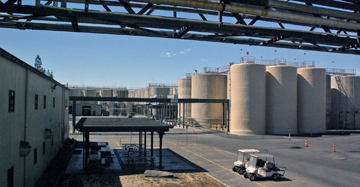 Most wineries in the United States are small boutique wineries. There are very few that are extremely large. Woodbridge Winery is a very large production winery. Plan to visit when you can take a tour. The 80-acre campus has many buildings all with different functions. It is wondrous to observe the entire campus working efficiently to produce millions of bottles of wine.
Most wineries in the United States are small boutique wineries. There are very few that are extremely large. Woodbridge Winery is a very large production winery. Plan to visit when you can take a tour. The 80-acre campus has many buildings all with different functions. It is wondrous to observe the entire campus working efficiently to produce millions of bottles of wine.
Woodbridge by Robert Mondavi
5950 E. Woodbridge Road
Acampo, California 95220
Article written September 2014
Visit these California organizations and wineries that partner with Wine Trail Traveler.
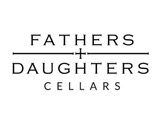 |
|||


